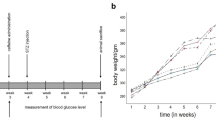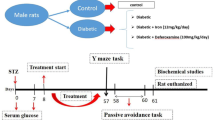Abstract
Because it appears that oxidative stress and inflammation are implicated with disease pathogenesis in the diabetic brain, many researchers have used streptozotocin (STZ)-induced diabetic animals to study superoxide production and the effects of superoxide scavengers like Cu,Zn-superoxide dismutase (SOD1). However, many studies have been conducted without considering temporal changes after STZ injection. Interestingly, though SOD activities were not significantly different among the groups, SOD1 and 4-hydroxy-2-nonenal (4-HNE) immunoreactivities were significantly enhanced at 3 weeks after an STZ injection (STZ3w) versus only marginal levels in sham controls, whereas microglial activity was remarkably reduced in injected rats at this time. However, SOD1 immunoreactivity and microglial activities were only at the sham level at STZ4w. The present study provides important information concerning cell damage by ROS generated by STZ. Microglial response was found to be inactivated at STZ3w and neuronal cells (NeuN) showed a non-significant tendency to be reduced in number at STZ4w except in the dentate gyrus. We speculated that the above oxidative stress-related events should be accomplished at STZ3w in the brains of STZ-induced diabetes animal models. Therefore, the aim of the present study was to investigate chronological changes in SOD1 immunoreactivity associated with lipid peroxidation and inflammatory responses in the hippocampi of STZ-induced type I diabetic rats.








Similar content being viewed by others
References
Bloomgarden ZT (1999) American diabetes association, annual meeting. Nephropathy and retinopathy. Diabetes Care 22:640–645
Guigliano D, Ceriello A, Paolisso G (1996) Oxidative stress and diabetic vascular complications. Diabetes Care 19:257–267
Özkaya YG, Agar A, Yargiçoglu P et al (2002) The effect of exercise on brain antioxidant status of diabetic rats. Diabetes Metab 28:377–384
Bayners JW (1991) Role of oxidative stress in the development of complications in diabetes. Diabetes 40:405–412
Karasu Ç, Dewhurst M, Stevens EJ et al (1995) Effects of anti-oxidant treatment on sciatic nerve dysfunction in streptozotocin-diabetic rats: comparison with essential fatty acids. Diabetologia 38:129–134
Karasu Ç (2000) Time course of changes in endothelium-dependent and—independent relaxation of chronically diabetic aorta: role of reactive oxygen species. Eur J Pharmacol 392:163–173
Ulusu NN, Sahilli M, Avci A et al (2003) Pentose phosphate pathway, glutathione-dependent enzymes and antioxidant defense during oxidative stress in diabetic rodent brain and peripheral organs: effects of stobadine and vitamin E. Neurochem Res 28:815–823
Leelavinothan P, Muniappan L (2004) Protective role of Scoparia dulcis plant extracts on brain antioxidant status and lipid peroxidation in STZ diabetic male Wistar rats. BMC Complement Altern Med 2:4–16
Brownlee M (2001) Biochemistry and molecular cell biology of diabetic complications. Nature 414:813–820
Celik S, Erdogan S (2008) Caffeic acid phenethyl ester (CAPE) protects brain against oxidative stress and inflammation induced by diabetes in rats. Mol Cell Biochem 312:39–46
Fridovich I (1995) Superoxide radical and superoxide dismutases. Annu Rev Biochem 64:97–112
Crapo JD, Oury T, Rabouille C et al (1992) Copper, zinc superoxide dismutase is primarily a cytosolic protein in human cells. Proc Natl Acad Sci USA 89:10405–10409
Oury TD, Tarto L, Ghio AJ et al (1995) Nitration of tyrosine by hydrogen peroxide and nitrite. Free Radic Res 23:537–547
Kawamura N, Oakawara T, Suzuki K et al (1992) Increased glycated Cu, Zn-Superoxide dismutase levels in erythrocytes of patients with insulin dependent-diabetes mellitus. J Clin Endocrinol Metab 74:1352–1354
McCord JM, Fridovich I (1969) The utility of superoxide dismutase in studying free radical reactions. I. Radicals generated by the interaction of sulfite, dimethyl sulfoxide, and oxygen. J Biol Chem 244:6056–6063
Beauchamp C, Fridovich I (1971) Superoxide dismutase: improved assays and an assay applicable to acrylamide gels. Anal Biochem 44:276–287
Ugochukwu NH, Cobourne MK (2003) Modification of renal oxidative stress and lipid peroxidation in streptozotocin-induced diabetic rats treated with extracts from Gongronema latifolium leaves. Clin Chim Acta 336:73–81
Singh N, Kamath V, Rajini PS (2005) Attenuation of hyperglycemia and associated biochemical parameters in STZ-induced diabetic rats by dietary supplementation of potato peel powder. Clin Chim Acta 353:165–175
Yue KK, Leung SN, Man PM et al (2005) Alterations in antioxidant enzyme activities in the eyes, aorta and kidney of diabetic rats relevant to the onset of oxidative stress. Life Sci 77:721–734
Carney JM, Strake-Reed PE, Oliver CN et al (1991) Reversal of age-related increase in brain protein oxidation, decrease in enzyme activity and loss in temporal and spatial memory by chronic administration of the spin trapping compound N-tert-buty-alfa-phenylnitrone. Proc Natl Acad Sci USA 88:3633–3636
Ugochukwu NH, Mukes JD, Figgers CL (2006) Ameliorative effects of dietary caloric restriction on oxidative stress and inflammation in the brain of streptozotocin-induced diabetic rats. Clin Chim Acta 370:165–173
Hong JH, Kim MJ, Park MR et al (2004) Effects of vitamin E on oxidative stress and membrane fluidity in brain of streptozotocin-induced diabetic rats. Clin Chim Acta 340:107–115
Aragno M, Mastrocola R, Catalano MG et al (2004) Oxidative stress impairs skeletal muscle repair in diabetic rats. Diabetes 53:1082–1088
Kamalakkannan N, Stanely Mainzen Prince P (2006) Rutin improves the antioxidant status in streptozotocin-induced diabetic rat tissues. Mol Cell Biochem 293:211–219
Nazaroglu NK, Sepici-Dincel A, Altan N (2009) The effects of sulfonylurea glyburide on superoxide dismutase, catalase, and glutathione peroxidase activities in the brain tissue of streptozotocin-induced diabetic rat. J Diabetes Complications 23:209–213
Mlakar A, Spiteller G (1996) Previously unknown aldehydic lipid peroxidation compounds of arachidonic acid. Chem Phys Lipids 79:47–53
Neely MD, Sidell KR, Graham DG, Montine TJ (1999) The lipid peroxidation product 4-hydroxynonenal inhibits neurite out-growth, disrupts neuronal microtubules, and modifies cellular tubulin. J Neurochem 72:2323–2333
Neely MD, Boutte A, Milatovic D, Montine TJ (2005) Mechanisms of 4-hydroxynoneal-induced neuronal microtubule dysfunction. Brain Res 1037:90–98
Kokubo J, Nagatani N, Hiroki K, Kuroiwa K, Watanabe N, Arai T (2008) Mechanism of destruction of microtubule structures by 4-hydroxy-2-nonenal. Cell Struct Funct 33:5089–5100
Ramanathan M, Jaiswal AK, Bhattacharya SK (1999) Superoxide dismutase, catalase and glutathione peroxidase activities in the brain of streptozotocin induced diabetic rats. Indian J Exp Biol 37:182–183
Kruman I, Bruce-Keler AJ, Bredesen D, Weag G, Mattson MP (1997) Evidence that 4-hydroxynonenyl mediates oxidative stress-induced neuronal apoptosis. J Neurosci 17:5089–5100
Soh Y, Jeong KS, Lee IJ, Bae MA, Kim YC, Song BJ (2000) Selective activation of the c-Jun N-terminal protein kinase pathway during 4-hydroxynonenal-induced apoptosis of PC12 cells. Mol Pharmacol 58:535–541
Bai J and Mei Y (2010) Overexpression of aldehyde dehydrogenase-2 attenuates neurotoxicity induced by 4-hydroxynonenal in cultured primary hippocampal neurons. Neurotox. Res. DOI: 10.1007/s12640-101-9183-1
Uchida K, Stadtman ER (1993) Covalent attachment of 4-hydroxynonenal to glyceraldehydes-3-phosphate dehydrogenase. J Biol Chem 268:6388–6393
Esterbauer H, Schaur RJ, Zollner H (1991) Chemistry and biochemistry of 4-hydroxynonenal malondialdehyde and related aldehydes. Free Radicals Biol Med 11:81–128
Deng HX, Hentati A, Tainer JA et al (1993) Amyotrophic lateral sclerosis and structural defects in Cu, Zn superoxide dismutase. Science 261:1047–1051
Bowling AC, Schulz JB, Brown RH Jr, Beal MF (1993) Superoxide dismutase activity, oxidative damage, and mitochondrial energy metabolism in familial and sporadic amyotrophic lateral sclerosis. J Neurochem 61:2322–2325
Ramanathan M, Jaiswal AK, Bhattacharya SK (1999) Superoxide dismutase, catalase and glutathione peroxidase activities in the brain of streptozotocin induced diabetic rats. Indian J Exp Biol 37:182–183
Huang WC, Juang SW, Liu IM et al (1999) Changes of superoxide dismutase, catalase and glutathione peroxidase activities in the brain of streptozotocin-induced diabetic rats. Neurosci Lett 275:25–28
Dimayuga FO, Wang C, Clark JM et al (2007) SOD1 overexpression alters ROS production and reduces neurotoxic inflammatory signaling in microglial cells. J Neuroimmunol 182:89–99
Nelson P, Soma L, Lavi E (2002) Microglia in disease of the central nervous system. Ann Med 34:491–500
Ling EA, Ng YK, Wu CH et al (2001) Microglia: its development and role as a neuropathology sensor. Prog Brain Res 132:61–79
Streit WJ, Walter SA, Pennell NA (1999) Reactive microliosis. Prog Neurobiol 57:563–581
Colton AC, Gilbert DL (1987) Production of superoxide by a CNS macrophage, the microglia. FEBS Lett 223:284–288
Banati RB, Gehrmann J, Schubert P et al (1993) Cytotoxicity of microglia. Glia 7:183–191
Gehrmann J, Matsumoto Y, Kreutzberg GW (1995) Microglia: intrinsic immuneffector cell of the brain. Brain Res Rev 20:269–287
Piani D, Fontana A (1994) Involvement of the cystine transport system Xc in the macrophage-induced glutamate-dependent cytotoxicity to neurons. J Immunol 153:3578–3585
Rozemuller JM, Eikelenboom P, Stam FC et al (1989) A4 protein in AD: primary and secondary cellular events in extracellular amyloid deposits. J Neuropath Exp Neurol 48:647–663
Moller JC, Klein MA, Haas S et al (1996) Regulation of thrombospondin in the regenerating mouse facial nucleus. Glia 17:121–132
Chang SC, Kao MC, Fu MT et al (2001) Modulation of NO and cytokines in microglial cells by Cu/Zn-superoxide dismutase. Free Radic Biol Med 31:1084–1089
Jöhren O, Gremmels JA, Qadri F et al (2006) Adrenal expression of orexin receptor subtypes is differentially regulated in experimental streptozotocin induced type-1 diabetes. Peptides 27:2764–2769
Jöhren O, Dendorfer A, Dominiak P et al (2007) Gene expression of mineralocorticoid and glucocorticoid receptors in the limbic system is related to type-2 like diabetes in leptin-resistant rats. Brain Res 1184:160–167
Schwartz MW, Strack AM, Dallman MF (1997) Evidence that elevated plasma corticosterone levels are the cause of reduced hypothalamic corticotrophin-releasing hormone gene expression in diabetes. Regul Pept 72:105–112
Zelena D, Mergl Z, Makara GB (2006) The role of vasopressin in diabetes mellitus-induced hypothalamo-pituitary-adrenal axis activation: studies in Brattleboro rats. Brain Res Bull 69:48–56
Yi SS, Hwang IK, Kim YN et al (2008) Enhanced expressions of arginine vasopressin (Avp) in the hypothalamic paraventricular and supraoptic nuclei of type 2 diabetic rats. Neurochem Res 33:833–841
Yi SS, Hwang IK, Chun MS et al (2009) Glucocorticoid receptor changes associate with age in the paraventricular nucleus of type II diabetic rat model. Neurochem Res 34:851–858
Qin L, Block ML, Liu Y et al (2005) Microglial NADPH oxidase is a novel target for femtomolar neuroprotection against oxidative stress. FASEB J 19:550–557
Block ML, Ki G, Qin L et al (2006) Potent regulation of microglia-derived oxidative stress and dopaminergic neuron survival: substance P vs. dynorphin. FASEB J 20:251–258
Polazzi E, Contestabile A (2002) Reciprocal interactions between microglia and neurons: from survival to neuropathology. Rev Neurosci 13:221–242
Lebed YV, Orlovsky MA, Tsupikov OM, Skibo GG, Pivneva TA (2008) Remodelling of ammon’s horn during the first 2 weeks of experimental diabetes development. Fiziol Zh 54:52–56
Biessels GJ, Cristino NA, Rutten GJ, Hamers FP, Erkelens DW, Gispen WH (1999) Neurophysiological changes in the central and peripheral nervous system of streptozotocin-diabetic rats. Course of development and effects of insulin treatment. Brain 122:757–768
Acknowledgments
The authors would like to thank Mr. Seung Uk Lee and Ms. Hyun Sook Kim for their technical help. This work was supported by a National Research Foundation of Grant funded by the Korean Government [NRF-2009-352-E00051].
Author information
Authors and Affiliations
Corresponding author
Rights and permissions
About this article
Cite this article
Yi, S.S., Hwang, I.K., Kim, D.W. et al. The Chronological Characteristics of SOD1 Activity and Inflammatory Response in the Hippocampi of STZ-Induced Type 1 Diabetic Rats. Neurochem Res 36, 117–128 (2011). https://doi.org/10.1007/s11064-010-0280-6
Accepted:
Published:
Issue Date:
DOI: https://doi.org/10.1007/s11064-010-0280-6




